The Impact of Mental Disorders: Causes, Treatments, and Social Factors
VerifiedAdded on 2023/01/12
|9
|3502
|98
Essay
AI Summary
This essay provides an in-depth analysis of mental disorders, exploring their causes, symptoms, and various treatment approaches. It delves into the biological and cognitive models, highlighting how these perspectives explain and address mental health issues. The essay examines the impact of mental disorders on individuals, including the offender population, and discusses different therapeutic interventions such as drug therapy, electroconvulsive therapy, and cognitive behavioral therapy. It emphasizes the importance of understanding mental disorders to improve treatment outcomes and address the challenges faced by individuals affected by these conditions. The essay also touches on the challenges of mental health in different age groups and social contexts. The essay highlights the importance of both biological and cognitive approaches to the treatment of mental disorders. The cognitive approach, which involves therapy, is particularly emphasized for its effectiveness in treating mental illnesses and helping offenders. The essay concludes by emphasizing the importance of understanding mental disorders and its impact on the offender population.
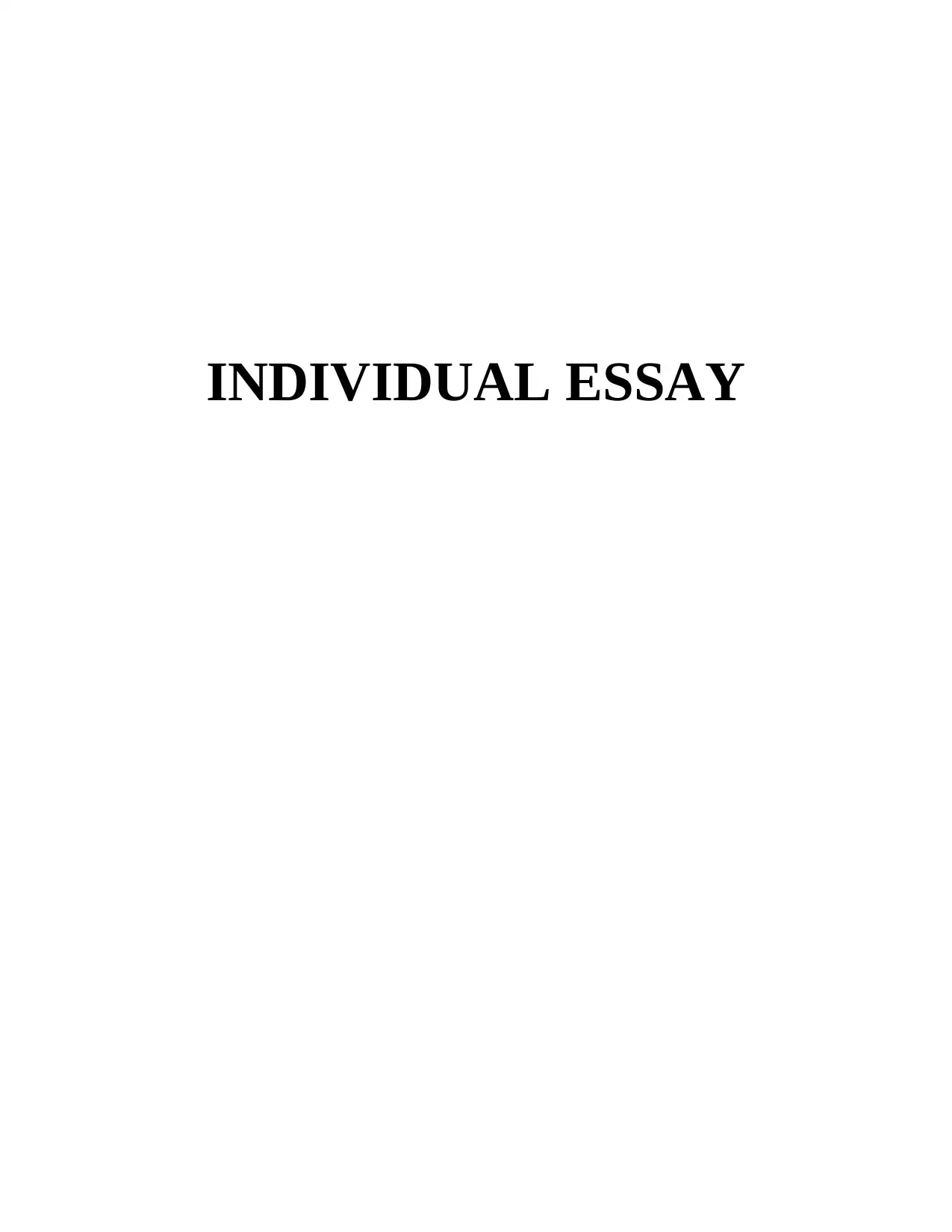
INDIVIDUAL ESSAY
Paraphrase This Document
Need a fresh take? Get an instant paraphrase of this document with our AI Paraphraser
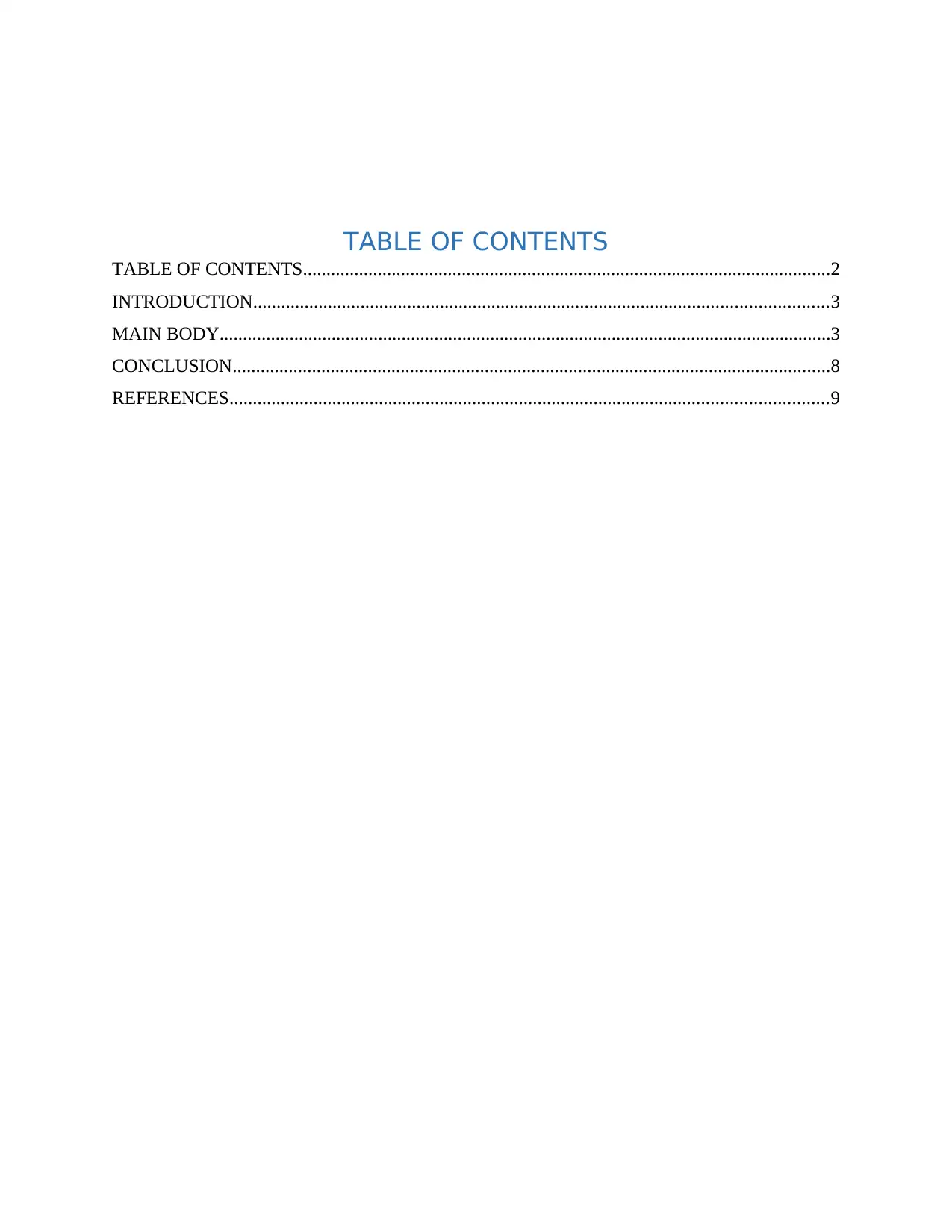
TABLE OF CONTENTS
TABLE OF CONTENTS.................................................................................................................2
INTRODUCTION...........................................................................................................................3
MAIN BODY...................................................................................................................................3
CONCLUSION................................................................................................................................8
REFERENCES................................................................................................................................9
TABLE OF CONTENTS.................................................................................................................2
INTRODUCTION...........................................................................................................................3
MAIN BODY...................................................................................................................................3
CONCLUSION................................................................................................................................8
REFERENCES................................................................................................................................9
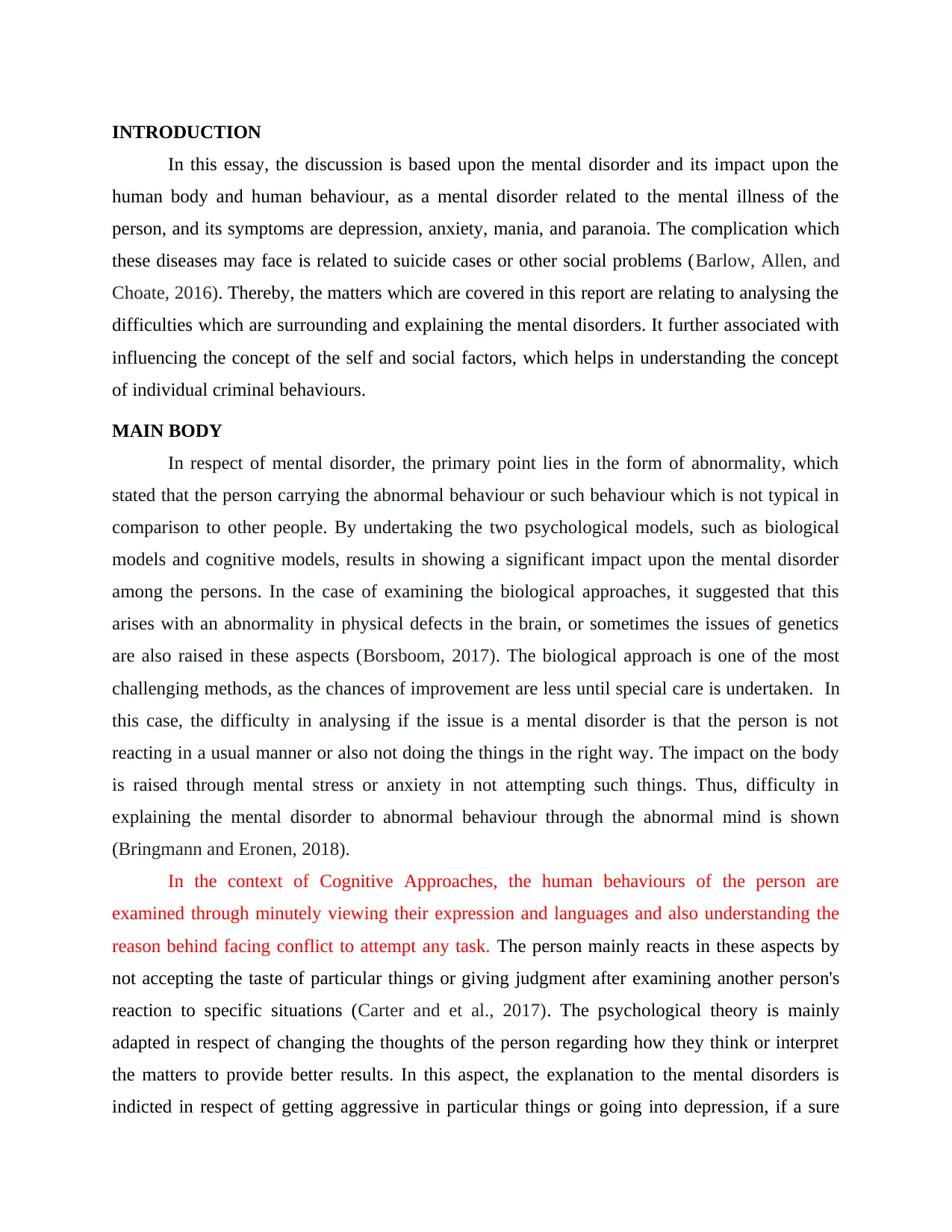
INTRODUCTION
In this essay, the discussion is based upon the mental disorder and its impact upon the
human body and human behaviour, as a mental disorder related to the mental illness of the
person, and its symptoms are depression, anxiety, mania, and paranoia. The complication which
these diseases may face is related to suicide cases or other social problems (Barlow, Allen, and
Choate, 2016). Thereby, the matters which are covered in this report are relating to analysing the
difficulties which are surrounding and explaining the mental disorders. It further associated with
influencing the concept of the self and social factors, which helps in understanding the concept
of individual criminal behaviours.
MAIN BODY
In respect of mental disorder, the primary point lies in the form of abnormality, which
stated that the person carrying the abnormal behaviour or such behaviour which is not typical in
comparison to other people. By undertaking the two psychological models, such as biological
models and cognitive models, results in showing a significant impact upon the mental disorder
among the persons. In the case of examining the biological approaches, it suggested that this
arises with an abnormality in physical defects in the brain, or sometimes the issues of genetics
are also raised in these aspects (Borsboom, 2017). The biological approach is one of the most
challenging methods, as the chances of improvement are less until special care is undertaken. In
this case, the difficulty in analysing if the issue is a mental disorder is that the person is not
reacting in a usual manner or also not doing the things in the right way. The impact on the body
is raised through mental stress or anxiety in not attempting such things. Thus, difficulty in
explaining the mental disorder to abnormal behaviour through the abnormal mind is shown
(Bringmann and Eronen, 2018).
In the context of Cognitive Approaches, the human behaviours of the person are
examined through minutely viewing their expression and languages and also understanding the
reason behind facing conflict to attempt any task. The person mainly reacts in these aspects by
not accepting the taste of particular things or giving judgment after examining another person's
reaction to specific situations (Carter and et al., 2017). The psychological theory is mainly
adapted in respect of changing the thoughts of the person regarding how they think or interpret
the matters to provide better results. In this aspect, the explanation to the mental disorders is
indicted in respect of getting aggressive in particular things or going into depression, if a sure
In this essay, the discussion is based upon the mental disorder and its impact upon the
human body and human behaviour, as a mental disorder related to the mental illness of the
person, and its symptoms are depression, anxiety, mania, and paranoia. The complication which
these diseases may face is related to suicide cases or other social problems (Barlow, Allen, and
Choate, 2016). Thereby, the matters which are covered in this report are relating to analysing the
difficulties which are surrounding and explaining the mental disorders. It further associated with
influencing the concept of the self and social factors, which helps in understanding the concept
of individual criminal behaviours.
MAIN BODY
In respect of mental disorder, the primary point lies in the form of abnormality, which
stated that the person carrying the abnormal behaviour or such behaviour which is not typical in
comparison to other people. By undertaking the two psychological models, such as biological
models and cognitive models, results in showing a significant impact upon the mental disorder
among the persons. In the case of examining the biological approaches, it suggested that this
arises with an abnormality in physical defects in the brain, or sometimes the issues of genetics
are also raised in these aspects (Borsboom, 2017). The biological approach is one of the most
challenging methods, as the chances of improvement are less until special care is undertaken. In
this case, the difficulty in analysing if the issue is a mental disorder is that the person is not
reacting in a usual manner or also not doing the things in the right way. The impact on the body
is raised through mental stress or anxiety in not attempting such things. Thus, difficulty in
explaining the mental disorder to abnormal behaviour through the abnormal mind is shown
(Bringmann and Eronen, 2018).
In the context of Cognitive Approaches, the human behaviours of the person are
examined through minutely viewing their expression and languages and also understanding the
reason behind facing conflict to attempt any task. The person mainly reacts in these aspects by
not accepting the taste of particular things or giving judgment after examining another person's
reaction to specific situations (Carter and et al., 2017). The psychological theory is mainly
adapted in respect of changing the thoughts of the person regarding how they think or interpret
the matters to provide better results. In this aspect, the explanation to the mental disorders is
indicted in respect of getting aggressive in particular things or going into depression, if a sure
⊘ This is a preview!⊘
Do you want full access?
Subscribe today to unlock all pages.

Trusted by 1+ million students worldwide
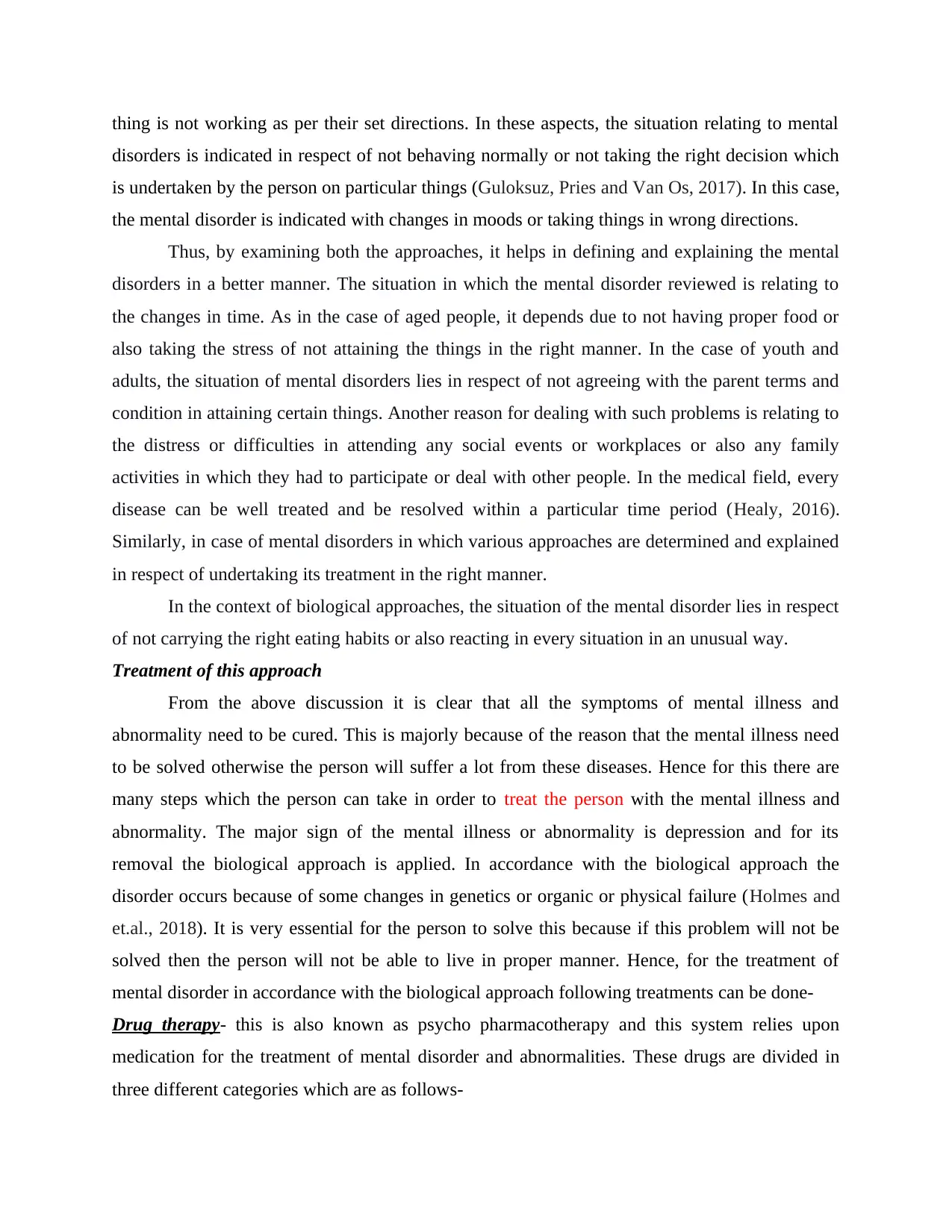
thing is not working as per their set directions. In these aspects, the situation relating to mental
disorders is indicated in respect of not behaving normally or not taking the right decision which
is undertaken by the person on particular things (Guloksuz, Pries and Van Os, 2017). In this case,
the mental disorder is indicated with changes in moods or taking things in wrong directions.
Thus, by examining both the approaches, it helps in defining and explaining the mental
disorders in a better manner. The situation in which the mental disorder reviewed is relating to
the changes in time. As in the case of aged people, it depends due to not having proper food or
also taking the stress of not attaining the things in the right manner. In the case of youth and
adults, the situation of mental disorders lies in respect of not agreeing with the parent terms and
condition in attaining certain things. Another reason for dealing with such problems is relating to
the distress or difficulties in attending any social events or workplaces or also any family
activities in which they had to participate or deal with other people. In the medical field, every
disease can be well treated and be resolved within a particular time period (Healy, 2016).
Similarly, in case of mental disorders in which various approaches are determined and explained
in respect of undertaking its treatment in the right manner.
In the context of biological approaches, the situation of the mental disorder lies in respect
of not carrying the right eating habits or also reacting in every situation in an unusual way.
Treatment of this approach
From the above discussion it is clear that all the symptoms of mental illness and
abnormality need to be cured. This is majorly because of the reason that the mental illness need
to be solved otherwise the person will suffer a lot from these diseases. Hence for this there are
many steps which the person can take in order to treat the person with the mental illness and
abnormality. The major sign of the mental illness or abnormality is depression and for its
removal the biological approach is applied. In accordance with the biological approach the
disorder occurs because of some changes in genetics or organic or physical failure (Holmes and
et.al., 2018). It is very essential for the person to solve this because if this problem will not be
solved then the person will not be able to live in proper manner. Hence, for the treatment of
mental disorder in accordance with the biological approach following treatments can be done-
Drug therapy- this is also known as psycho pharmacotherapy and this system relies upon
medication for the treatment of mental disorder and abnormalities. These drugs are divided in
three different categories which are as follows-
disorders is indicated in respect of not behaving normally or not taking the right decision which
is undertaken by the person on particular things (Guloksuz, Pries and Van Os, 2017). In this case,
the mental disorder is indicated with changes in moods or taking things in wrong directions.
Thus, by examining both the approaches, it helps in defining and explaining the mental
disorders in a better manner. The situation in which the mental disorder reviewed is relating to
the changes in time. As in the case of aged people, it depends due to not having proper food or
also taking the stress of not attaining the things in the right manner. In the case of youth and
adults, the situation of mental disorders lies in respect of not agreeing with the parent terms and
condition in attaining certain things. Another reason for dealing with such problems is relating to
the distress or difficulties in attending any social events or workplaces or also any family
activities in which they had to participate or deal with other people. In the medical field, every
disease can be well treated and be resolved within a particular time period (Healy, 2016).
Similarly, in case of mental disorders in which various approaches are determined and explained
in respect of undertaking its treatment in the right manner.
In the context of biological approaches, the situation of the mental disorder lies in respect
of not carrying the right eating habits or also reacting in every situation in an unusual way.
Treatment of this approach
From the above discussion it is clear that all the symptoms of mental illness and
abnormality need to be cured. This is majorly because of the reason that the mental illness need
to be solved otherwise the person will suffer a lot from these diseases. Hence for this there are
many steps which the person can take in order to treat the person with the mental illness and
abnormality. The major sign of the mental illness or abnormality is depression and for its
removal the biological approach is applied. In accordance with the biological approach the
disorder occurs because of some changes in genetics or organic or physical failure (Holmes and
et.al., 2018). It is very essential for the person to solve this because if this problem will not be
solved then the person will not be able to live in proper manner. Hence, for the treatment of
mental disorder in accordance with the biological approach following treatments can be done-
Drug therapy- this is also known as psycho pharmacotherapy and this system relies upon
medication for the treatment of mental disorder and abnormalities. These drugs are divided in
three different categories which are as follows-
Paraphrase This Document
Need a fresh take? Get an instant paraphrase of this document with our AI Paraphraser
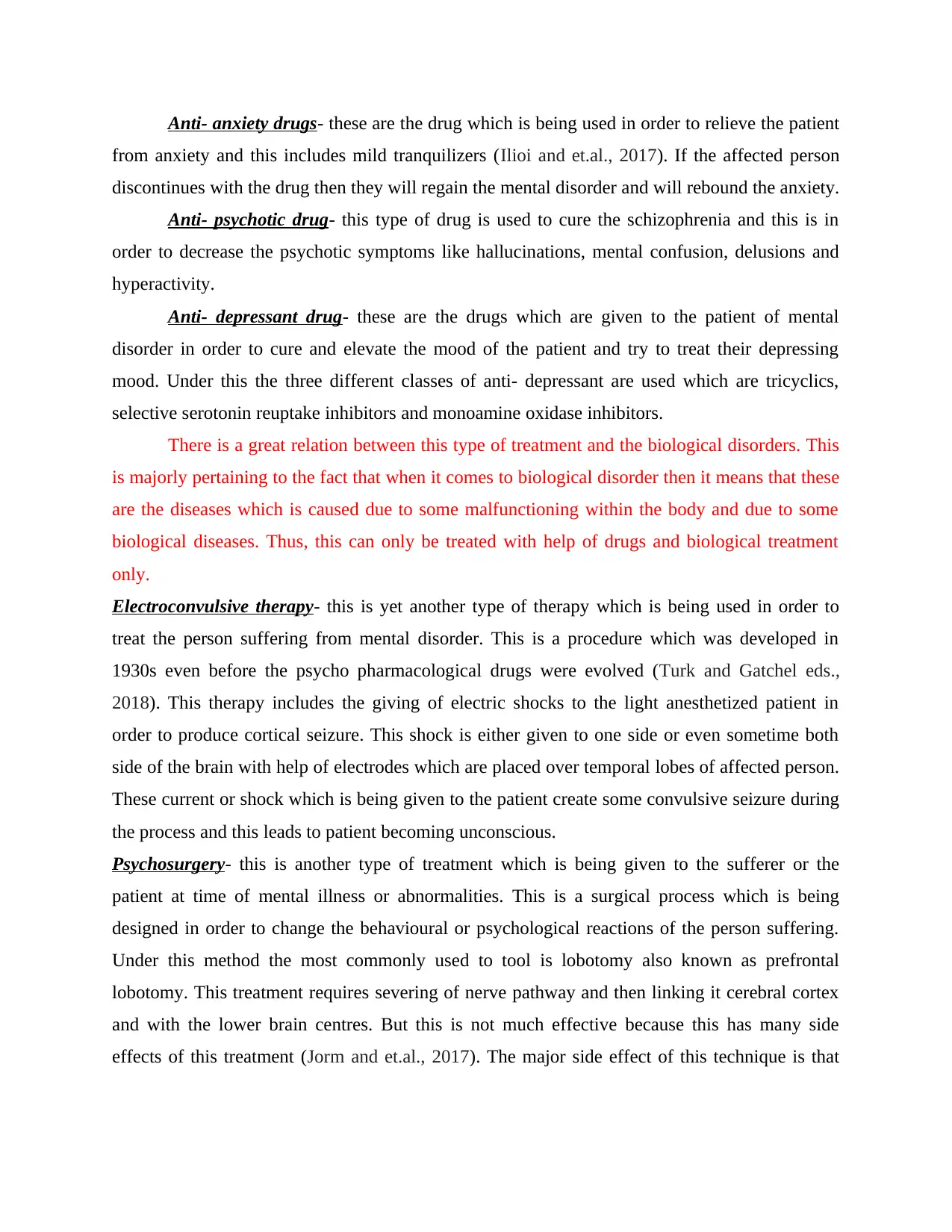
Anti- anxiety drugs- these are the drug which is being used in order to relieve the patient
from anxiety and this includes mild tranquilizers (Ilioi and et.al., 2017). If the affected person
discontinues with the drug then they will regain the mental disorder and will rebound the anxiety.
Anti- psychotic drug- this type of drug is used to cure the schizophrenia and this is in
order to decrease the psychotic symptoms like hallucinations, mental confusion, delusions and
hyperactivity.
Anti- depressant drug- these are the drugs which are given to the patient of mental
disorder in order to cure and elevate the mood of the patient and try to treat their depressing
mood. Under this the three different classes of anti- depressant are used which are tricyclics,
selective serotonin reuptake inhibitors and monoamine oxidase inhibitors.
There is a great relation between this type of treatment and the biological disorders. This
is majorly pertaining to the fact that when it comes to biological disorder then it means that these
are the diseases which is caused due to some malfunctioning within the body and due to some
biological diseases. Thus, this can only be treated with help of drugs and biological treatment
only.
Electroconvulsive therapy- this is yet another type of therapy which is being used in order to
treat the person suffering from mental disorder. This is a procedure which was developed in
1930s even before the psycho pharmacological drugs were evolved (Turk and Gatchel eds.,
2018). This therapy includes the giving of electric shocks to the light anesthetized patient in
order to produce cortical seizure. This shock is either given to one side or even sometime both
side of the brain with help of electrodes which are placed over temporal lobes of affected person.
These current or shock which is being given to the patient create some convulsive seizure during
the process and this leads to patient becoming unconscious.
Psychosurgery- this is another type of treatment which is being given to the sufferer or the
patient at time of mental illness or abnormalities. This is a surgical process which is being
designed in order to change the behavioural or psychological reactions of the person suffering.
Under this method the most commonly used to tool is lobotomy also known as prefrontal
lobotomy. This treatment requires severing of nerve pathway and then linking it cerebral cortex
and with the lower brain centres. But this is not much effective because this has many side
effects of this treatment (Jorm and et.al., 2017). The major side effect of this technique is that
from anxiety and this includes mild tranquilizers (Ilioi and et.al., 2017). If the affected person
discontinues with the drug then they will regain the mental disorder and will rebound the anxiety.
Anti- psychotic drug- this type of drug is used to cure the schizophrenia and this is in
order to decrease the psychotic symptoms like hallucinations, mental confusion, delusions and
hyperactivity.
Anti- depressant drug- these are the drugs which are given to the patient of mental
disorder in order to cure and elevate the mood of the patient and try to treat their depressing
mood. Under this the three different classes of anti- depressant are used which are tricyclics,
selective serotonin reuptake inhibitors and monoamine oxidase inhibitors.
There is a great relation between this type of treatment and the biological disorders. This
is majorly pertaining to the fact that when it comes to biological disorder then it means that these
are the diseases which is caused due to some malfunctioning within the body and due to some
biological diseases. Thus, this can only be treated with help of drugs and biological treatment
only.
Electroconvulsive therapy- this is yet another type of therapy which is being used in order to
treat the person suffering from mental disorder. This is a procedure which was developed in
1930s even before the psycho pharmacological drugs were evolved (Turk and Gatchel eds.,
2018). This therapy includes the giving of electric shocks to the light anesthetized patient in
order to produce cortical seizure. This shock is either given to one side or even sometime both
side of the brain with help of electrodes which are placed over temporal lobes of affected person.
These current or shock which is being given to the patient create some convulsive seizure during
the process and this leads to patient becoming unconscious.
Psychosurgery- this is another type of treatment which is being given to the sufferer or the
patient at time of mental illness or abnormalities. This is a surgical process which is being
designed in order to change the behavioural or psychological reactions of the person suffering.
Under this method the most commonly used to tool is lobotomy also known as prefrontal
lobotomy. This treatment requires severing of nerve pathway and then linking it cerebral cortex
and with the lower brain centres. But this is not much effective because this has many side
effects of this treatment (Jorm and et.al., 2017). The major side effect of this technique is that
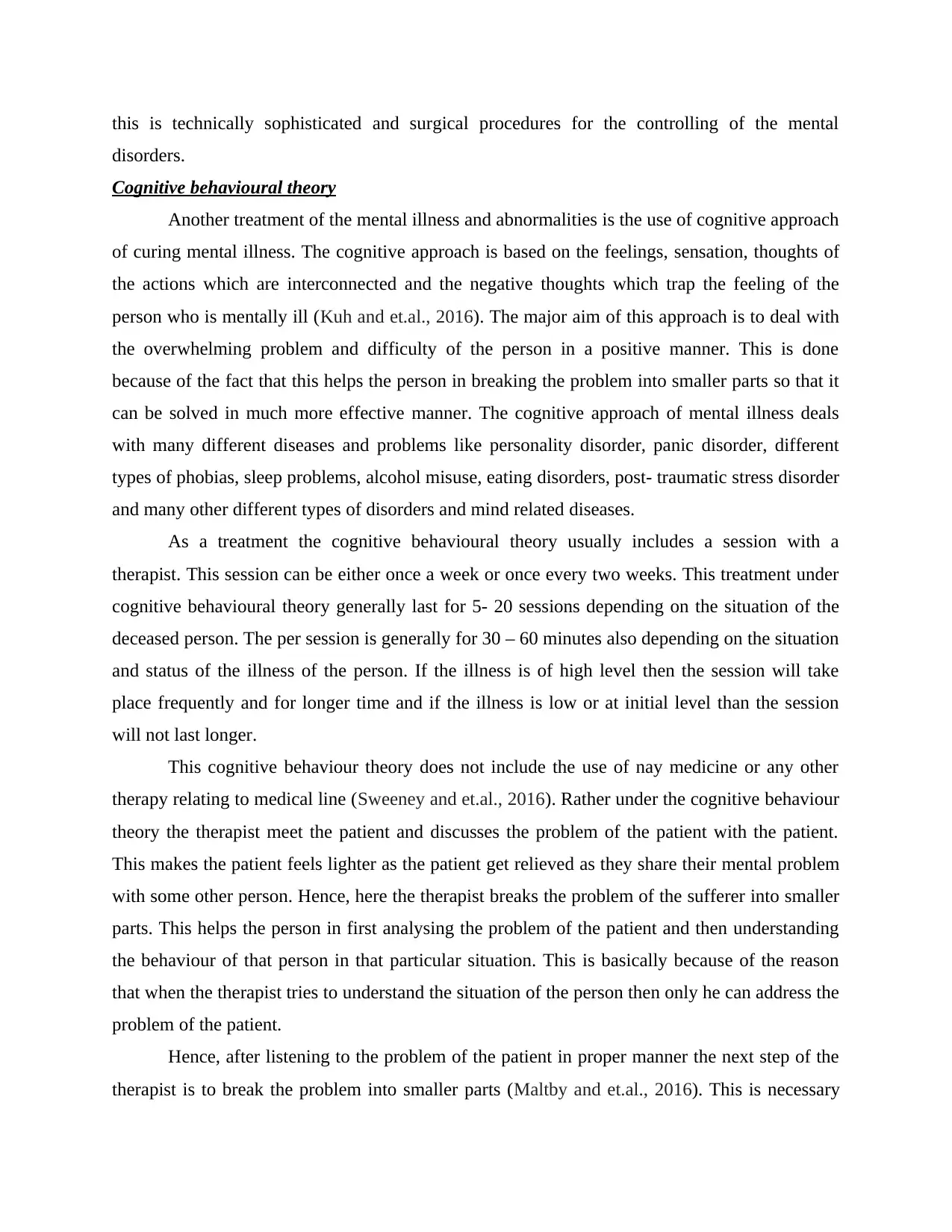
this is technically sophisticated and surgical procedures for the controlling of the mental
disorders.
Cognitive behavioural theory
Another treatment of the mental illness and abnormalities is the use of cognitive approach
of curing mental illness. The cognitive approach is based on the feelings, sensation, thoughts of
the actions which are interconnected and the negative thoughts which trap the feeling of the
person who is mentally ill (Kuh and et.al., 2016). The major aim of this approach is to deal with
the overwhelming problem and difficulty of the person in a positive manner. This is done
because of the fact that this helps the person in breaking the problem into smaller parts so that it
can be solved in much more effective manner. The cognitive approach of mental illness deals
with many different diseases and problems like personality disorder, panic disorder, different
types of phobias, sleep problems, alcohol misuse, eating disorders, post- traumatic stress disorder
and many other different types of disorders and mind related diseases.
As a treatment the cognitive behavioural theory usually includes a session with a
therapist. This session can be either once a week or once every two weeks. This treatment under
cognitive behavioural theory generally last for 5- 20 sessions depending on the situation of the
deceased person. The per session is generally for 30 – 60 minutes also depending on the situation
and status of the illness of the person. If the illness is of high level then the session will take
place frequently and for longer time and if the illness is low or at initial level than the session
will not last longer.
This cognitive behaviour theory does not include the use of nay medicine or any other
therapy relating to medical line (Sweeney and et.al., 2016). Rather under the cognitive behaviour
theory the therapist meet the patient and discusses the problem of the patient with the patient.
This makes the patient feels lighter as the patient get relieved as they share their mental problem
with some other person. Hence, here the therapist breaks the problem of the sufferer into smaller
parts. This helps the person in first analysing the problem of the patient and then understanding
the behaviour of that person in that particular situation. This is basically because of the reason
that when the therapist tries to understand the situation of the person then only he can address the
problem of the patient.
Hence, after listening to the problem of the patient in proper manner the next step of the
therapist is to break the problem into smaller parts (Maltby and et.al., 2016). This is necessary
disorders.
Cognitive behavioural theory
Another treatment of the mental illness and abnormalities is the use of cognitive approach
of curing mental illness. The cognitive approach is based on the feelings, sensation, thoughts of
the actions which are interconnected and the negative thoughts which trap the feeling of the
person who is mentally ill (Kuh and et.al., 2016). The major aim of this approach is to deal with
the overwhelming problem and difficulty of the person in a positive manner. This is done
because of the fact that this helps the person in breaking the problem into smaller parts so that it
can be solved in much more effective manner. The cognitive approach of mental illness deals
with many different diseases and problems like personality disorder, panic disorder, different
types of phobias, sleep problems, alcohol misuse, eating disorders, post- traumatic stress disorder
and many other different types of disorders and mind related diseases.
As a treatment the cognitive behavioural theory usually includes a session with a
therapist. This session can be either once a week or once every two weeks. This treatment under
cognitive behavioural theory generally last for 5- 20 sessions depending on the situation of the
deceased person. The per session is generally for 30 – 60 minutes also depending on the situation
and status of the illness of the person. If the illness is of high level then the session will take
place frequently and for longer time and if the illness is low or at initial level than the session
will not last longer.
This cognitive behaviour theory does not include the use of nay medicine or any other
therapy relating to medical line (Sweeney and et.al., 2016). Rather under the cognitive behaviour
theory the therapist meet the patient and discusses the problem of the patient with the patient.
This makes the patient feels lighter as the patient get relieved as they share their mental problem
with some other person. Hence, here the therapist breaks the problem of the sufferer into smaller
parts. This helps the person in first analysing the problem of the patient and then understanding
the behaviour of that person in that particular situation. This is basically because of the reason
that when the therapist tries to understand the situation of the person then only he can address the
problem of the patient.
Hence, after listening to the problem of the patient in proper manner the next step of the
therapist is to break the problem into smaller parts (Maltby and et.al., 2016). This is necessary
⊘ This is a preview!⊘
Do you want full access?
Subscribe today to unlock all pages.

Trusted by 1+ million students worldwide
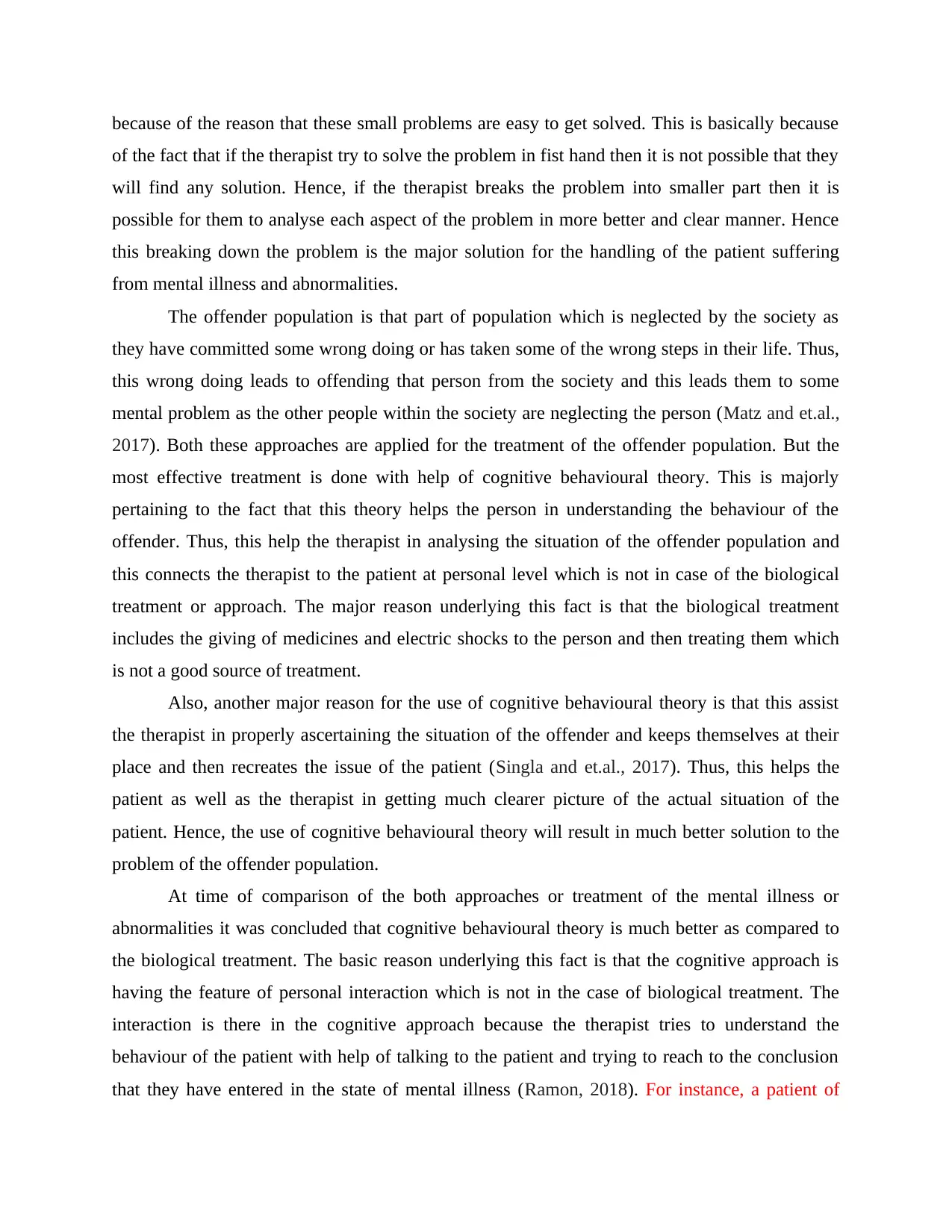
because of the reason that these small problems are easy to get solved. This is basically because
of the fact that if the therapist try to solve the problem in fist hand then it is not possible that they
will find any solution. Hence, if the therapist breaks the problem into smaller part then it is
possible for them to analyse each aspect of the problem in more better and clear manner. Hence
this breaking down the problem is the major solution for the handling of the patient suffering
from mental illness and abnormalities.
The offender population is that part of population which is neglected by the society as
they have committed some wrong doing or has taken some of the wrong steps in their life. Thus,
this wrong doing leads to offending that person from the society and this leads them to some
mental problem as the other people within the society are neglecting the person (Matz and et.al.,
2017). Both these approaches are applied for the treatment of the offender population. But the
most effective treatment is done with help of cognitive behavioural theory. This is majorly
pertaining to the fact that this theory helps the person in understanding the behaviour of the
offender. Thus, this help the therapist in analysing the situation of the offender population and
this connects the therapist to the patient at personal level which is not in case of the biological
treatment or approach. The major reason underlying this fact is that the biological treatment
includes the giving of medicines and electric shocks to the person and then treating them which
is not a good source of treatment.
Also, another major reason for the use of cognitive behavioural theory is that this assist
the therapist in properly ascertaining the situation of the offender and keeps themselves at their
place and then recreates the issue of the patient (Singla and et.al., 2017). Thus, this helps the
patient as well as the therapist in getting much clearer picture of the actual situation of the
patient. Hence, the use of cognitive behavioural theory will result in much better solution to the
problem of the offender population.
At time of comparison of the both approaches or treatment of the mental illness or
abnormalities it was concluded that cognitive behavioural theory is much better as compared to
the biological treatment. The basic reason underlying this fact is that the cognitive approach is
having the feature of personal interaction which is not in the case of biological treatment. The
interaction is there in the cognitive approach because the therapist tries to understand the
behaviour of the patient with help of talking to the patient and trying to reach to the conclusion
that they have entered in the state of mental illness (Ramon, 2018). For instance, a patient of
of the fact that if the therapist try to solve the problem in fist hand then it is not possible that they
will find any solution. Hence, if the therapist breaks the problem into smaller part then it is
possible for them to analyse each aspect of the problem in more better and clear manner. Hence
this breaking down the problem is the major solution for the handling of the patient suffering
from mental illness and abnormalities.
The offender population is that part of population which is neglected by the society as
they have committed some wrong doing or has taken some of the wrong steps in their life. Thus,
this wrong doing leads to offending that person from the society and this leads them to some
mental problem as the other people within the society are neglecting the person (Matz and et.al.,
2017). Both these approaches are applied for the treatment of the offender population. But the
most effective treatment is done with help of cognitive behavioural theory. This is majorly
pertaining to the fact that this theory helps the person in understanding the behaviour of the
offender. Thus, this help the therapist in analysing the situation of the offender population and
this connects the therapist to the patient at personal level which is not in case of the biological
treatment or approach. The major reason underlying this fact is that the biological treatment
includes the giving of medicines and electric shocks to the person and then treating them which
is not a good source of treatment.
Also, another major reason for the use of cognitive behavioural theory is that this assist
the therapist in properly ascertaining the situation of the offender and keeps themselves at their
place and then recreates the issue of the patient (Singla and et.al., 2017). Thus, this helps the
patient as well as the therapist in getting much clearer picture of the actual situation of the
patient. Hence, the use of cognitive behavioural theory will result in much better solution to the
problem of the offender population.
At time of comparison of the both approaches or treatment of the mental illness or
abnormalities it was concluded that cognitive behavioural theory is much better as compared to
the biological treatment. The basic reason underlying this fact is that the cognitive approach is
having the feature of personal interaction which is not in the case of biological treatment. The
interaction is there in the cognitive approach because the therapist tries to understand the
behaviour of the patient with help of talking to the patient and trying to reach to the conclusion
that they have entered in the state of mental illness (Ramon, 2018). For instance, a patient of
Paraphrase This Document
Need a fresh take? Get an instant paraphrase of this document with our AI Paraphraser
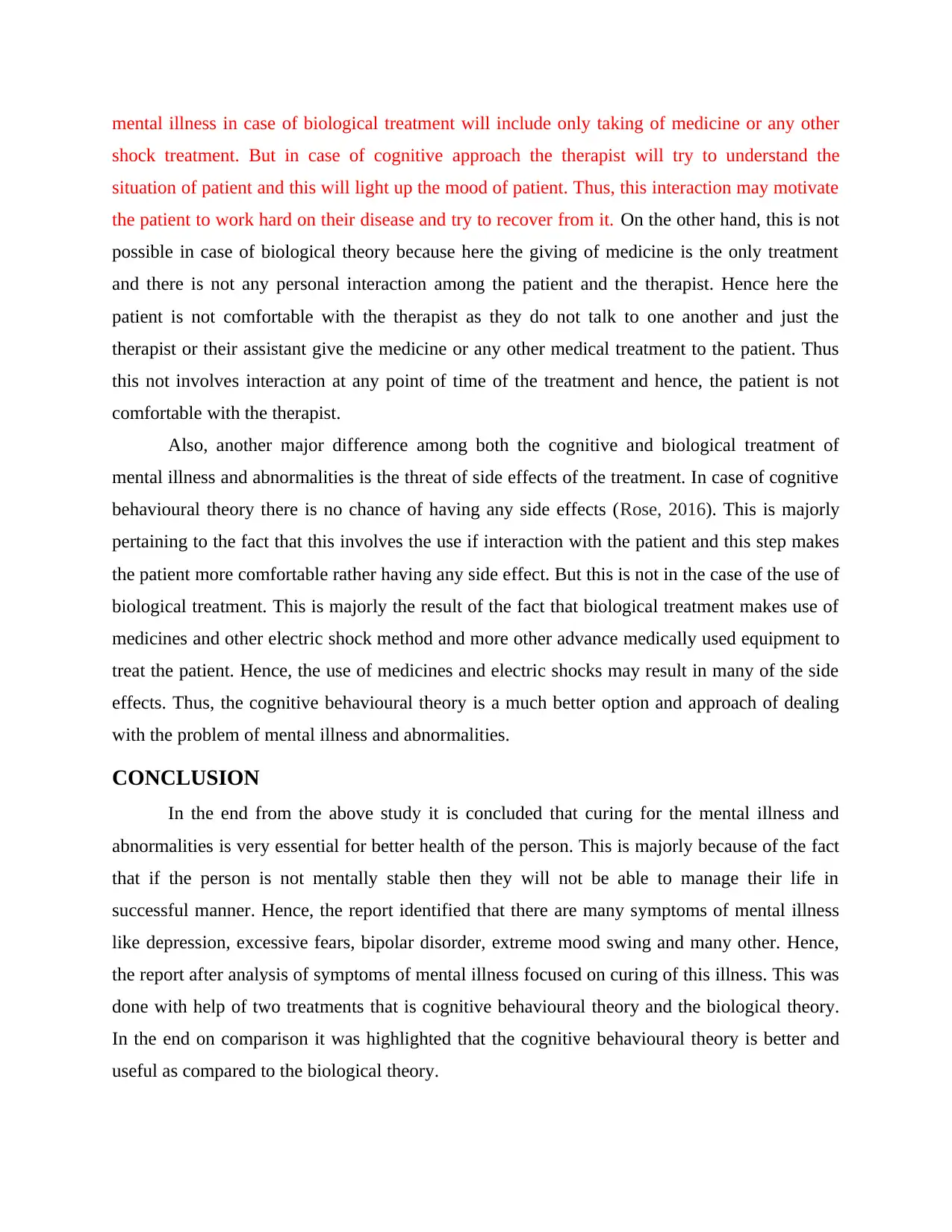
mental illness in case of biological treatment will include only taking of medicine or any other
shock treatment. But in case of cognitive approach the therapist will try to understand the
situation of patient and this will light up the mood of patient. Thus, this interaction may motivate
the patient to work hard on their disease and try to recover from it. On the other hand, this is not
possible in case of biological theory because here the giving of medicine is the only treatment
and there is not any personal interaction among the patient and the therapist. Hence here the
patient is not comfortable with the therapist as they do not talk to one another and just the
therapist or their assistant give the medicine or any other medical treatment to the patient. Thus
this not involves interaction at any point of time of the treatment and hence, the patient is not
comfortable with the therapist.
Also, another major difference among both the cognitive and biological treatment of
mental illness and abnormalities is the threat of side effects of the treatment. In case of cognitive
behavioural theory there is no chance of having any side effects (Rose, 2016). This is majorly
pertaining to the fact that this involves the use if interaction with the patient and this step makes
the patient more comfortable rather having any side effect. But this is not in the case of the use of
biological treatment. This is majorly the result of the fact that biological treatment makes use of
medicines and other electric shock method and more other advance medically used equipment to
treat the patient. Hence, the use of medicines and electric shocks may result in many of the side
effects. Thus, the cognitive behavioural theory is a much better option and approach of dealing
with the problem of mental illness and abnormalities.
CONCLUSION
In the end from the above study it is concluded that curing for the mental illness and
abnormalities is very essential for better health of the person. This is majorly because of the fact
that if the person is not mentally stable then they will not be able to manage their life in
successful manner. Hence, the report identified that there are many symptoms of mental illness
like depression, excessive fears, bipolar disorder, extreme mood swing and many other. Hence,
the report after analysis of symptoms of mental illness focused on curing of this illness. This was
done with help of two treatments that is cognitive behavioural theory and the biological theory.
In the end on comparison it was highlighted that the cognitive behavioural theory is better and
useful as compared to the biological theory.
shock treatment. But in case of cognitive approach the therapist will try to understand the
situation of patient and this will light up the mood of patient. Thus, this interaction may motivate
the patient to work hard on their disease and try to recover from it. On the other hand, this is not
possible in case of biological theory because here the giving of medicine is the only treatment
and there is not any personal interaction among the patient and the therapist. Hence here the
patient is not comfortable with the therapist as they do not talk to one another and just the
therapist or their assistant give the medicine or any other medical treatment to the patient. Thus
this not involves interaction at any point of time of the treatment and hence, the patient is not
comfortable with the therapist.
Also, another major difference among both the cognitive and biological treatment of
mental illness and abnormalities is the threat of side effects of the treatment. In case of cognitive
behavioural theory there is no chance of having any side effects (Rose, 2016). This is majorly
pertaining to the fact that this involves the use if interaction with the patient and this step makes
the patient more comfortable rather having any side effect. But this is not in the case of the use of
biological treatment. This is majorly the result of the fact that biological treatment makes use of
medicines and other electric shock method and more other advance medically used equipment to
treat the patient. Hence, the use of medicines and electric shocks may result in many of the side
effects. Thus, the cognitive behavioural theory is a much better option and approach of dealing
with the problem of mental illness and abnormalities.
CONCLUSION
In the end from the above study it is concluded that curing for the mental illness and
abnormalities is very essential for better health of the person. This is majorly because of the fact
that if the person is not mentally stable then they will not be able to manage their life in
successful manner. Hence, the report identified that there are many symptoms of mental illness
like depression, excessive fears, bipolar disorder, extreme mood swing and many other. Hence,
the report after analysis of symptoms of mental illness focused on curing of this illness. This was
done with help of two treatments that is cognitive behavioural theory and the biological theory.
In the end on comparison it was highlighted that the cognitive behavioural theory is better and
useful as compared to the biological theory.
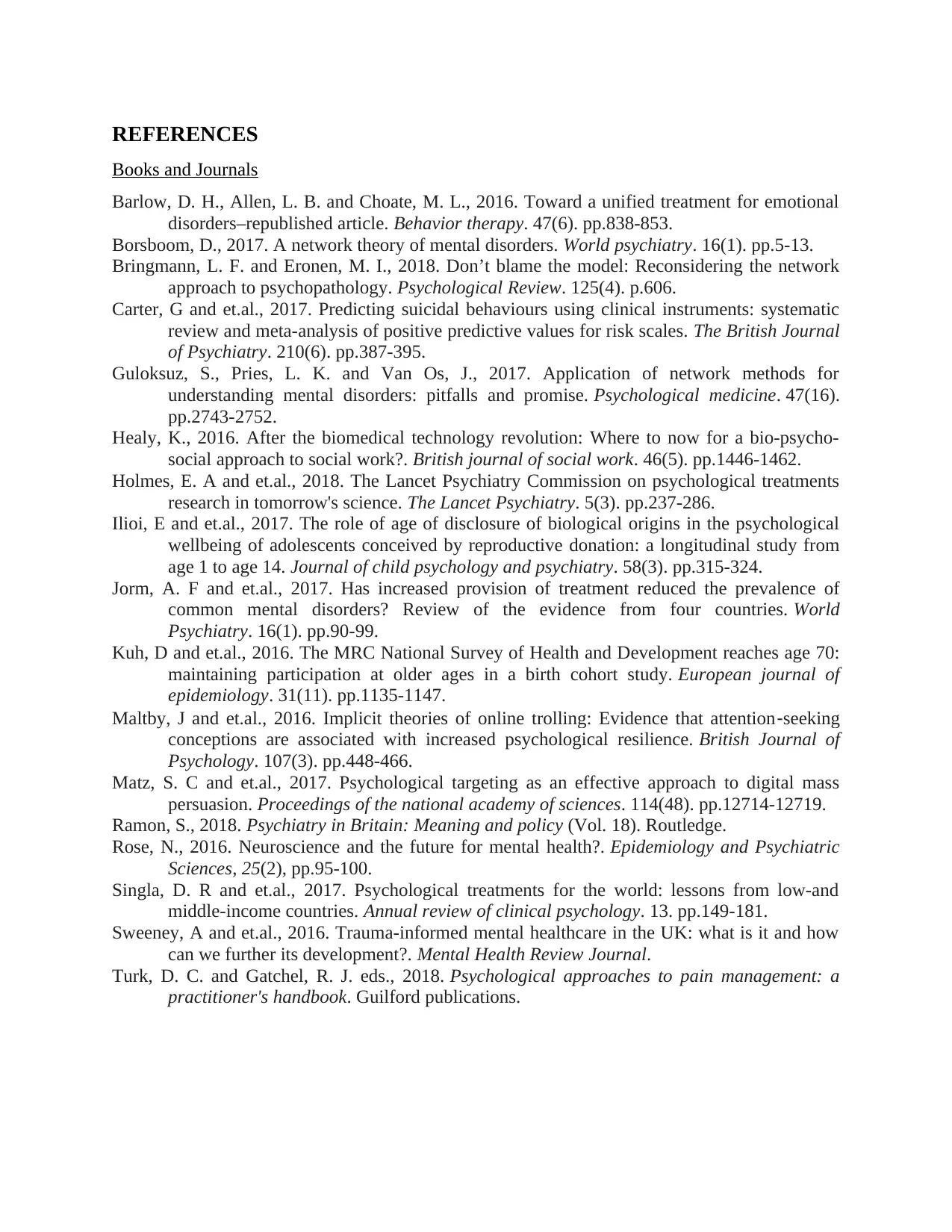
REFERENCES
Books and Journals
Barlow, D. H., Allen, L. B. and Choate, M. L., 2016. Toward a unified treatment for emotional
disorders–republished article. Behavior therapy. 47(6). pp.838-853.
Borsboom, D., 2017. A network theory of mental disorders. World psychiatry. 16(1). pp.5-13.
Bringmann, L. F. and Eronen, M. I., 2018. Don’t blame the model: Reconsidering the network
approach to psychopathology. Psychological Review. 125(4). p.606.
Carter, G and et.al., 2017. Predicting suicidal behaviours using clinical instruments: systematic
review and meta-analysis of positive predictive values for risk scales. The British Journal
of Psychiatry. 210(6). pp.387-395.
Guloksuz, S., Pries, L. K. and Van Os, J., 2017. Application of network methods for
understanding mental disorders: pitfalls and promise. Psychological medicine. 47(16).
pp.2743-2752.
Healy, K., 2016. After the biomedical technology revolution: Where to now for a bio-psycho-
social approach to social work?. British journal of social work. 46(5). pp.1446-1462.
Holmes, E. A and et.al., 2018. The Lancet Psychiatry Commission on psychological treatments
research in tomorrow's science. The Lancet Psychiatry. 5(3). pp.237-286.
Ilioi, E and et.al., 2017. The role of age of disclosure of biological origins in the psychological
wellbeing of adolescents conceived by reproductive donation: a longitudinal study from
age 1 to age 14. Journal of child psychology and psychiatry. 58(3). pp.315-324.
Jorm, A. F and et.al., 2017. Has increased provision of treatment reduced the prevalence of
common mental disorders? Review of the evidence from four countries. World
Psychiatry. 16(1). pp.90-99.
Kuh, D and et.al., 2016. The MRC National Survey of Health and Development reaches age 70:
maintaining participation at older ages in a birth cohort study. European journal of
epidemiology. 31(11). pp.1135-1147.
Maltby, J and et.al., 2016. Implicit theories of online trolling: Evidence that attention‐seeking
conceptions are associated with increased psychological resilience. British Journal of
Psychology. 107(3). pp.448-466.
Matz, S. C and et.al., 2017. Psychological targeting as an effective approach to digital mass
persuasion. Proceedings of the national academy of sciences. 114(48). pp.12714-12719.
Ramon, S., 2018. Psychiatry in Britain: Meaning and policy (Vol. 18). Routledge.
Rose, N., 2016. Neuroscience and the future for mental health?. Epidemiology and Psychiatric
Sciences, 25(2), pp.95-100.
Singla, D. R and et.al., 2017. Psychological treatments for the world: lessons from low-and
middle-income countries. Annual review of clinical psychology. 13. pp.149-181.
Sweeney, A and et.al., 2016. Trauma-informed mental healthcare in the UK: what is it and how
can we further its development?. Mental Health Review Journal.
Turk, D. C. and Gatchel, R. J. eds., 2018. Psychological approaches to pain management: a
practitioner's handbook. Guilford publications.
Books and Journals
Barlow, D. H., Allen, L. B. and Choate, M. L., 2016. Toward a unified treatment for emotional
disorders–republished article. Behavior therapy. 47(6). pp.838-853.
Borsboom, D., 2017. A network theory of mental disorders. World psychiatry. 16(1). pp.5-13.
Bringmann, L. F. and Eronen, M. I., 2018. Don’t blame the model: Reconsidering the network
approach to psychopathology. Psychological Review. 125(4). p.606.
Carter, G and et.al., 2017. Predicting suicidal behaviours using clinical instruments: systematic
review and meta-analysis of positive predictive values for risk scales. The British Journal
of Psychiatry. 210(6). pp.387-395.
Guloksuz, S., Pries, L. K. and Van Os, J., 2017. Application of network methods for
understanding mental disorders: pitfalls and promise. Psychological medicine. 47(16).
pp.2743-2752.
Healy, K., 2016. After the biomedical technology revolution: Where to now for a bio-psycho-
social approach to social work?. British journal of social work. 46(5). pp.1446-1462.
Holmes, E. A and et.al., 2018. The Lancet Psychiatry Commission on psychological treatments
research in tomorrow's science. The Lancet Psychiatry. 5(3). pp.237-286.
Ilioi, E and et.al., 2017. The role of age of disclosure of biological origins in the psychological
wellbeing of adolescents conceived by reproductive donation: a longitudinal study from
age 1 to age 14. Journal of child psychology and psychiatry. 58(3). pp.315-324.
Jorm, A. F and et.al., 2017. Has increased provision of treatment reduced the prevalence of
common mental disorders? Review of the evidence from four countries. World
Psychiatry. 16(1). pp.90-99.
Kuh, D and et.al., 2016. The MRC National Survey of Health and Development reaches age 70:
maintaining participation at older ages in a birth cohort study. European journal of
epidemiology. 31(11). pp.1135-1147.
Maltby, J and et.al., 2016. Implicit theories of online trolling: Evidence that attention‐seeking
conceptions are associated with increased psychological resilience. British Journal of
Psychology. 107(3). pp.448-466.
Matz, S. C and et.al., 2017. Psychological targeting as an effective approach to digital mass
persuasion. Proceedings of the national academy of sciences. 114(48). pp.12714-12719.
Ramon, S., 2018. Psychiatry in Britain: Meaning and policy (Vol. 18). Routledge.
Rose, N., 2016. Neuroscience and the future for mental health?. Epidemiology and Psychiatric
Sciences, 25(2), pp.95-100.
Singla, D. R and et.al., 2017. Psychological treatments for the world: lessons from low-and
middle-income countries. Annual review of clinical psychology. 13. pp.149-181.
Sweeney, A and et.al., 2016. Trauma-informed mental healthcare in the UK: what is it and how
can we further its development?. Mental Health Review Journal.
Turk, D. C. and Gatchel, R. J. eds., 2018. Psychological approaches to pain management: a
practitioner's handbook. Guilford publications.
⊘ This is a preview!⊘
Do you want full access?
Subscribe today to unlock all pages.

Trusted by 1+ million students worldwide
1 out of 9
Related Documents
Your All-in-One AI-Powered Toolkit for Academic Success.
+13062052269
info@desklib.com
Available 24*7 on WhatsApp / Email
![[object Object]](/_next/static/media/star-bottom.7253800d.svg)
Unlock your academic potential
Copyright © 2020–2025 A2Z Services. All Rights Reserved. Developed and managed by ZUCOL.





